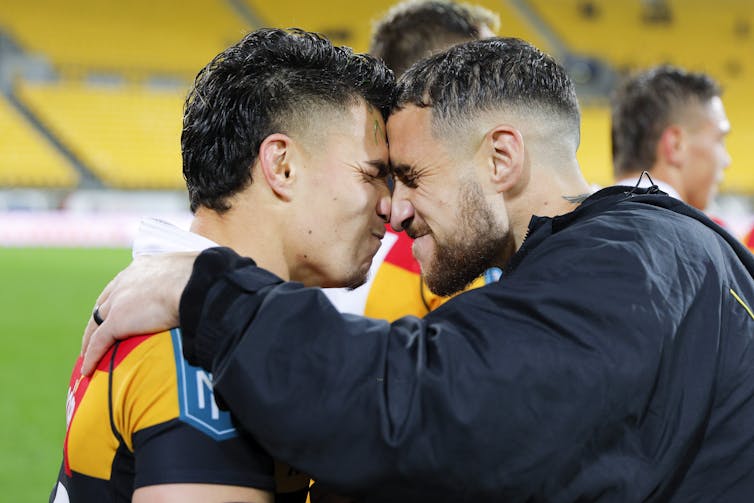Sports and language revitalisation
Dion Enari and Sierra Keung
24 May 2023

‘You can’t speak what you can’t hear’ – how Māori and Pacific sports stars are helping revitalise vulnerable languages
We’re becoming more used to hearing and seeing te reo Māori in everyday use these days. And Pacific languages are becoming increasingly familiar too – especially during the now under way.
But if there’s one forum that has seen a genuine surge in the use of Indigenous languages it’s the world of elite sport. It’s a reflection of the felt by Māori and Pacific athletes – and it’s one more way these vulnerable languages are being kept alive in Aotearoa New Zealand.
Take women’s rugby star Ruby Tui, for example, who broke into her native Samoan during an impromptu interview with a BBC reporter during the Olympic Games in 2021.
After her Black Ferns team won the 2022 women’s Rugby World Cup, Tui led the crowd in a spontaneous rendition of the classic Māori waiata (song) “Tutira Mai Ngā Iwi” – making in the process.
Tui joins other high-profile Māori and Pacific players such as All Blacks , , and Black Ferns star , who have all used their mother tongues during interviews.
Vulnerable languages
This is more than a feel-good phenomenon. Public figures using their native languages on the big stage support the revitalisation efforts being made by Indigenous people in general.
Despite te reo Māori being an official language of Aotearoa New Zealand, and Samoan being the country’s third-most-spoken language (and in Auckland), there are still real concerns for their long-term survival.
Te reo Māori is on the UNESCO endangered languages list, and the number of Samoan speakers among the diaspora populations is .
New Zealand census data show only 3% of the population can speak te reo Māori, and only 2% Samoan. In fact, these numbers may be an overestimation of language capability, with the . It is thought that, without deliberate effort, language loss .

Collective cultural values
On a positive note, it wasn’t very long ago that Indigenous athletes would only speak English during interviews. So the fact they will now use their star status to of their culture and language is a sign of progress.
In the process, these athletes are making inroads into what has largely been a . In fact, it might be better to think of them not as athletes of Indigenous heritage, but rather as Indigenous people who happen to be athletes.
This is something our . Many of these athletes feel a to their families, villages, tribes and nations – not only to play well, but to use their profile to benefit their people.
This runs counter in some ways to the often individualistic values and financial priorities of commercial sports. Even in the hyper-competitive world of American football (NFL), Pacific players have managed to to the fore.
Since its inception in 2017, the has celebrated the legacy of Polynesian NFL players, with a Polynesian Hall of Fame, as well as through an ambassador programme and high school all-star game – with a on the NFL network.
‘More than just words’
All these initiatives suggest there is another place where bilingual proficiency could make a difference – the commentary box.

There have already been examples of this – notably various initiatives by Whakaata Māori (Māori Television), including te reo Māori commentary during the and .
In 2019, Sky Sport also offered a te reo Māori option for matches broadcast during te wiki o te reo Māori (Māori Language Week). The same year, Sky piloted a Pacific language for the Pasifika Challenge rugby event. Samoan, Tongan and Fijian commentaries were made available for all matches.
Television New Zealand and Spark Sport also offered te reo Māori commentary at this year’s . Former Black Cap Peter McGlashan (Ngāti Porou) explained his involvement this way:
My grandma grew up in a time when Māori were prohibited from speaking their language – it was beaten out of us. So this is something very special to me.
Te reo Māori is about so much more than just words. It’s the story of a culture that you can’t articulate accurately in any other language. It’s important we keep using it.
Part of the purpose of the commentary initiative, of course, was to attract more Māori to cricket. With that will come more role models and more opportunities to put the culture on the field. As McGlashan also said:
It’s just like the language. You can’t speak what you can’t hear. And you can’t be what you can’t see.
, Lecturer in Sport and Recreation, and , Lecturer in Sport and Recreation,
This article is republished from under a Creative Commons license. Read the .